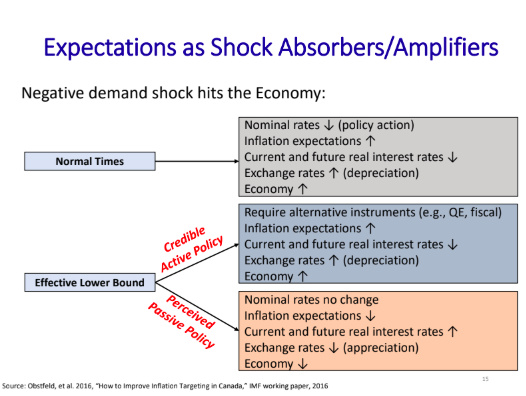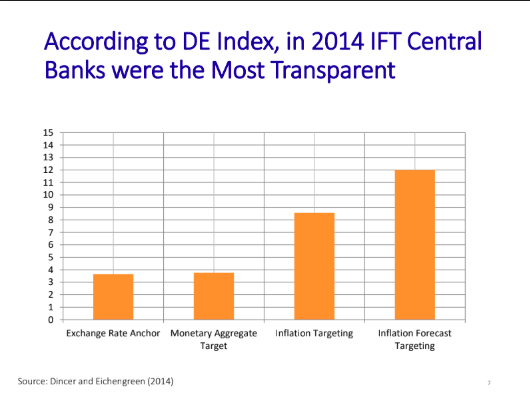 On Monday, 17 June 2019 Bank Indonesia Institute hosted the first FKP event of the month. Sharing his 25 years of experience working with central banks, Douglas Laxton (NOVA School of Business and Economics Portugal and former IMF economist) discussed the many dimensions of inflation targeting and its application in Indonesia. His presentation is based on his book entitled Advancing the Frontiers of Monetary Policy co-authored with Tobias Adrian and Maurice Obstfeld.
On Monday, 17 June 2019 Bank Indonesia Institute hosted the first FKP event of the month. Sharing his 25 years of experience working with central banks, Douglas Laxton (NOVA School of Business and Economics Portugal and former IMF economist) discussed the many dimensions of inflation targeting and its application in Indonesia. His presentation is based on his book entitled Advancing the Frontiers of Monetary Policy co-authored with Tobias Adrian and Maurice Obstfeld.
Inflation forecast targeting (IFT) means that the central bank uses the forecasted inflation rate as the economy’s ideal inflation target. This is done to communicate how the central bank is managing the trade-off between the economy’s short-run output and inflation rate. By communicating, central banks influence long term interest rates, which will consequently affect consumer and firm behaviours, as well as asset prices like the exchange rate.
To see the difference between IFT and non-IFT central banks, Laxton compared two ends of the spectrum: Canada and Korea. As the second country in the world to implement IFT in their central bank, long-term inflation expectation in Canada are completely anchored. Conversely, in Korea long term inflation expectation are pulled around by the current rate of inflation. In general, a successful IFT central bank is characterized by accountability and transparency, forecasting and policy analysis systems, successful experience of keeping inflation near target, and a credible monetary policy.  A key point in having a credible monetary policy is to have asset prices that act as shock absorbers, as opposed to amplifiers. This means that when there is a shock that moves inflation off the target, asset prices are going to move strongly in a way that anticipates future policy, which can either be the conventional path of the policy rate, or the market’s belief of what the policy will be. To illustrate, when there is a negative economic news, even without any action by the central bank, the public is going to expect a cut in the interest rates. As a result, the currency will depreciate, and inflation expectations will rise back to the target, real interest rates will decline, causing the currency to depreciate, the economy will improve, and the rate of inflation will return to the target. However, in the case of an effective lower bound on interest rates, there will be higher interest rates in the future, which will cause the appreciation of real exchange rates. In this case, asset prices act as shock amplifiers. Without a policy intervention, the economy can spiral out of control.
A key point in having a credible monetary policy is to have asset prices that act as shock absorbers, as opposed to amplifiers. This means that when there is a shock that moves inflation off the target, asset prices are going to move strongly in a way that anticipates future policy, which can either be the conventional path of the policy rate, or the market’s belief of what the policy will be. To illustrate, when there is a negative economic news, even without any action by the central bank, the public is going to expect a cut in the interest rates. As a result, the currency will depreciate, and inflation expectations will rise back to the target, real interest rates will decline, causing the currency to depreciate, the economy will improve, and the rate of inflation will return to the target. However, in the case of an effective lower bound on interest rates, there will be higher interest rates in the future, which will cause the appreciation of real exchange rates. In this case, asset prices act as shock amplifiers. Without a policy intervention, the economy can spiral out of control.
Finally, Laxton asserted the superiority of a conventional forward guidance in comparison to an unconventional forward guidance. A conventional forward guidance is a monetary policy instrument, which is characterized by the central bank’s provision of information regarding its future monetary policy intentions based on its economic outlook. This instrument is successfully used by the Czech Central Bank to mitigate the impacts of the 2008 financial crisis. Before the crisis, the Czech Central Bank communicated the tendency of a global economic will slowdown, which means that there is a tendency for the policy rate to fall over time. With a conventional forward guidance, the baseline forecast is used as a reference. As a result, everything can be logically coherent and consistent and policymakers can explain their positions in reference to the baseline forecast. In contrast, an unconventional forward guidance often tries to talk the interest down, the way The Fed did in the USA, thus leaving the actual message unclear. This type of forward guidance can be dangerous because it may misrepresent the degree of uncertainty in the future and oversimplify policy objectives to the public.
For the complete presentation and Q&A session, please refer to the video and materials provided.





